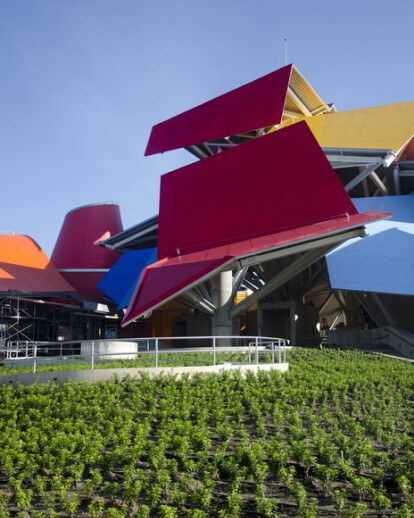The Biomuseo will tell the story of the rise of the isthmus of Panama and how this event changed the natural world, as we know it.
It is the first building in Latin America designed by the famous architect Frank Gehry.
Since 2001, an international team of architects, designers, and members of the scientific community have been working on the design and development of the museum, which will be a gateway to new knowledge about the natural history of the isthmus and its biodiversity.
The Amador Foundation, a Panamanian nonprofit organization, promotes the Biomuseum.
The Biomuseo is an affiliate of the Smithsonian Institute. Panama is the only country, outside the United States, with museums affiliated to the Smithsonian.
A team of experts from the Smithsonian Institute and the University of Panama developed the Biomuseo’s scientific content. The conceptual design of the museum’s galleries is the work of Bruce Mau Design, one of the leading design firms in the world.
The Biomuseo’s educational program will address 40 thousand students from public schools, free of charge, every year.
The Biomuseo offers the opportunity to discover the value of Panama’s biodiversity. We hope that Panamanians take pride in their history and identity, as custodians of a site of unparalleled importance in the natural world.
The Biomuseoaims to:
a) Educate. Instruct visitors and the public about the importance of biodiversity, and especially the one found in Panama. To achieve this goal, we have taken a new approach to the traditional exhibition concept, with displays designed to produce a sensory impact, thus motivating learning and discovery, and combining technology, art, and design. b) Create a network of exchanges. The museum will be a place where visitors can learn about the natural and cultural wealth of Panama. The project is intended to produce a sustained international effect that will help generate a new understanding of the wealth of the twenty-first century: the wealth of our natural economy. c) Convey. The museum aims to become a landmark, a symbol of global concern for the environment and conservation, and in turn, spread to the world Panama’s extraordinary natural heritage. As a result, the Bimouseowill become an essential attraction for Panamanians and foreigners alike.
The Biomuseo will promote education in general, bringing together in Panama leading scientific resources.
The Biomuseo will attract over half a million visitors per year.
In addition, the Biomuseo will become a major tourist attraction that will encourage the investment climate in Panama.
Panama is the logical home of the BIOMUSEUM because of its biodiversity and history.
Panama has one of the highest concentrations of different (known) species, in a territory of only 75,000 square kilometers.
The isthmus has more species of birds, mammals, reptiles and plants than those of the United States and Canada combined.
3 million years ago, the emergence of the isthmus of Panama changed the climate and biodiversity on the planet, playing a key role in the creation of the natural world we know today.
The Biomuseohas eight galleries that will transform the museum experience of Panama.
The Biomuseo’s central exhibition is titled Panama: Bridge of Life.
The Biomuseo offers visitors eight "devices of wonder", linking the emergence of the isthmus of Panama to the biological and climatic changes that transformed the natural world we know today.
a) Gallery of Biodiversity. This gallery introduces the subject of biodiversity, the work of local scientists, and the current health of our environment. The visitors will be greeted with a multicolored stained glass, 14 meters long and 8 meters high. b) Panamarama. A projection space with three different heights and ten screens will plunge the visitor into a visual and acoustic rendering of Panama’s natural wonders. c) Building the Bridge. To illustrate the creation and emergence of the isthmus, three 14-meter high rock formations will be exhibited. We will learn how this event changed the climate and influenced all living species. d) Worlds Collide. The closure of the isthmus of Panama generated a great exchange of species between North and South America, two land masses that had been separated for 70 million years. Two sculptural groups of animals will reproduce the megafauna that participated in this unique journey. e) The Human Path. In a partially open-air space, sixteen columns will provide information on the relationship between human activity and Panama’s natural scenery, from 15,000 years ago—the estimated date when the first settlers arrived to the isthmus—to the present. f) Oceans Divided. When Panama emerged, two very different oceans were formed, changing life all over the Earth. Two 10-meter high, semi-cylindrical aquariums will show how the Pacific and the Caribbean evolved in drastically different ways after being separated by the creation of the isthmus. g) The Living Web. To demonstrate how living things need and compete with each other in complex and invisible ways, a huge sculpture—part plant, animal, insect, and microorganism—will illustrate visitors. h) Panama is the Museum. What we will have visited so far is mere representation. This gallery will serve as a physical interface, a springboard to start the real journey through Panama, putting us in direct contact with our biodiversity.
THE ARCHITECTURE
The work of Frank Gehry, more than any other architect, closely resembles that of a contemporary artist and sculptor. In the Biomuseo we can see many references to local culture and biodiversity (colors) and canal architecture (roofs and architectural forms).
The building directs our gaze to the landscape and integrates with it. Positioned at the beginning of the Amador Causeway and the entrance to the Canal, it seems to float like another ship, bursting with color.
OPENING
The Biomuseo will open its doors in 2014.






























